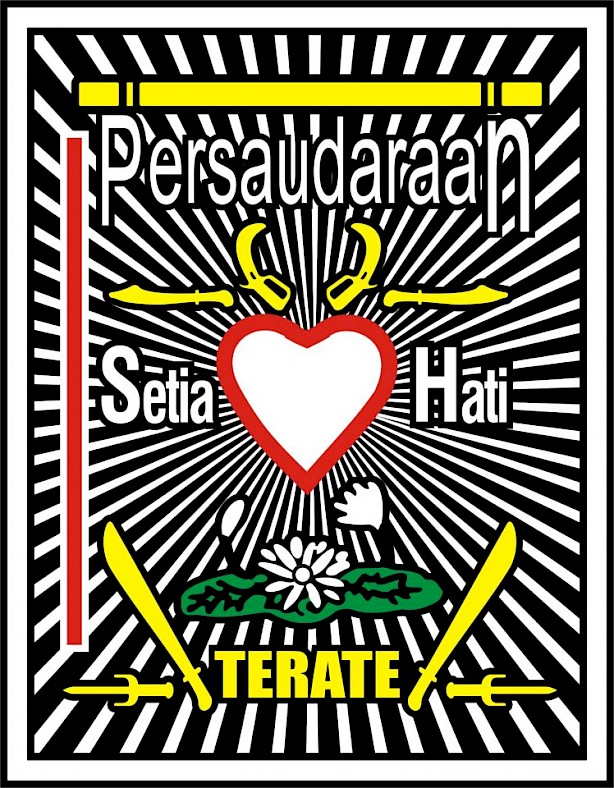Persaudaraan Setia Hati “Terate”
" The goal of the Persaudaraan Setia Hati Terate is to propagate a system of personal development for the mind and the body. "
Logo

Organization
This Pentjak Silat style is one of the largest and most widespread styles in Indonesia.
The physical and spiritual ‘epicenter” of the Persaudaraan Setia Hati Terate is the city of Madiun, in East Java, Indonesia. In this city of 600,000 inhabitants, some 15% of the population is actively involved in the PSHT.
The PSHT currently counts some 1.5 million members in Indonesia spread over 177 “Cabang” (Cities or Districts). The Head Office and the Central Board of PSHT organization is in Madiun located in East part of Java.
Madiun is also home to the central organizing board of the PSHT. The current chairman of the Central Board (Pengurus Pusat) is Mas Tarmadji Boedi Harsono.
The scope of the PSHT is broader than fighting arts alone. The PSHT is also a social-cultural organization, with its own educational programmed. It organizes educational and social-cultural activities for the local community. It maintains good contact with the government and other social-cultural organizations. And members of the PSHT maintain responsible positions in the community.
History
In 1903, Ki Ageng Soerodiwirjo laid the groundwork for a Pentjak Silat Setia Hati style. Previously he called the Physical / Movement of his Pentjak Silat “Djojo Gendilo Tjipto Muljo” and the Spiritual called “Sedulur Tunggal Ketjer” , in Kampoeng Tambak Gringsing, Surabaya. In 1917 Ki Ageng Soerodiwirjo moved to Madiun and establish his style named the Persaudaraan Setia Hati in Desa Winongo, Madiun. The Persaudaraan Setia Hati is not an organization, it just a brotherhood among the student (kadang), as at that time the Pencak Silat organization was not allowed by Dutch Colonialism. “Setia Hati” means “Faithful Heart”. Soerodiwirjo was born to an aristocratic family in Madiun, East Java, Indonesia, in the last quarter of the 19th Century. He was eventually dubbed a “Ngabei”, an exclusive aristocratic title extended by the Sultan only to those who have proven themselves spiritually worthy. He lived and worked in various locations on both Java and Sumatra, were he studied diverse styles of Pentjak Silat. On Sumatra, he also studied under a spiritual teacher. The combination of this spiritual teaching (kebatinan) and that which he had distilled from the diverse fighting arts styles formed the basis for Setia Hati. Ki Ageng Hadji Soerodiwirjo died on 10 November 1944 in Madiun.
In 1922, Hardjo Oetomo (1883-1952), a follower of the Setia Hati style, ask permission of Ki Ageng Soerodiwirjo to establish the Setia Hati School for younger generation and was permitted by Ki Ageng Soerodiwirjo, but has to be in different name. Mr. Hardjo Oetomo than establish “SH PSC” stand for Persaudaraan Setia Hati “Pemuda Sport Club”. This system was then called Persaudaraan Setia Hati Terate or PSHT in 1948 during the first congress in Madiun.
After World War II, the PSHT continued to spread throughout Indonesia. An important figure behind this growing popularity was Mr. Irsjad the first student of Ki Hadjar Hardjooetomo who created 90 Senam Dasar (Basic Exercise), Jurus Belati (Jurus with Knife), and Jurus Toya (Jurus with Long Stick). One of student of Mr. Irsjad is Mas Imam Koessoepangat (1939-1987), the spiritual leader of the PSHT at the time. His successor, Mas Tarmadji Boedi Harsono, is the current leader of the PSHT central board.
Philosophy
The Art of self-defense
Each eastern self-defense art is based on a philosophy with an associated code of ethics. This also applies to Pentjak Silat. The practice of a self-defense art has the objective of helping the student develop a forthright character by living according to the fundamental norms and values of the art. The student strives for harmony in body and spirit, in intellect and emotion.
Persaudaraan Setia Hati Terate is a way of living, a life’s path. The element of sport is just a small aspect, one of the many stones from which the path of the PSHT is paved. With this broader approach, the Persaudaraan Setia Hati Terate is not a fighting sport but a fighting art. A fighting sport is a struggle with another. A fighting art is a struggle with oneself.
Basic rules
Striving toward harmony in body and mind, the Persaudaraan Setia Hati Terate is founded on five basic principles:
1. Persaudaraan (Brotherhood or fraternity)
2. Olah Raga (Sport)
3. Bela Diri (Self-defense)
4. Seni Budaya (Art and culture)
5. Kerokhanian Ke SH an (Spiritual development)
